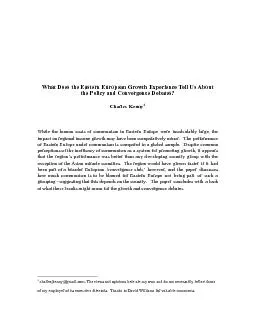/


with theexception of the Asian ofRussia ID: 106105
Download Pdf The PPT/PDF document "Charles Kenny1While the human costs of c..." is the property of its rightful owner. Permission is granted to download and print the materials on this web site for personal, non-commercial use only, and to display it on your personal computer provided you do not modify the materials and that you retain all copyright notices contained in the materials. By downloading content from our website, you accept the terms of this agreement.
Charles Kenny1While the human costs of communism in with theexception of the Asian ofRussiaÕs exports were produced by an agricultural sector that lagged fifty years behindGermanyÕs or BritainÕs in terms of productivity. The First World War and the revolutiondestroyed most of the small stock of industrial capacity, while decimating the rural laborforce. In 1920, the gross value of output in large-scale industry was estimated to havebeen 12.8 percent of its 1913 level. The country did not return to its pre-war level ofproduction until 1927.But between then and the outbreak of the Second World War, at the same time as Stalinmassacred millions, economic progress was dramatic. Between 1929 and 1937, the 2 Between 1950 and 1970, the USSR was the 16th fastest growingcountry out of the same forty-country sample used above. In the 1970-88 period, theUSSR did collapse to 7th slowest (although still growing faster than New Zealand,Switzerland, Argentina, Chile, Peru and Venezuela in that period). But even after this 3 more wealthy and exhaust the opportunities for increasing per capita capital stocks, theyconverge to a Ôsteady stateÕ economic growth rate reliant on technological advance,considered the same for all countries.The problem with this model is that there has been unconditional divergence in incomesover the last thirty years, and a fairly simple mathematical exercise suggests thisdivergence must have been occurring for far longer (Quah, 1993, Pritchett, 1998).Easterly et. al. (199?) have suggested that the only developing the factor(s) that are 9 poorest and the richest, richest. If rankings change, this is a sign of differing policyoutcomes, external shocks, or changing effects of initial conditions. Second, in the absenceof impediments, a ranking of countries by initial income should be perfectly negatively 1 does Eastern Europe perform on these tests? dropped from 14 to 12.4 from1950-88. Western Europe and the Westernoffshoots, resource rents (Sachs 1997). Arelated set of studies looks at the impact of neighbor wealth (Kenny, 1999) and neighborgrowth (Easterly and Levine 1996) and suggest another reason why regional membershipmight be significant in determining growth rates.If such long-term extra-policy factors are important in determining convergence clubmembership Ðand the fairly predictable ranking of income per capita between countriesover long periods is more evidence that they might be (Kenny, 1999), it still might be thatEastern European countries were fairly ÔWesternÕ in these non-policy factors in the War One in the same Empire with them, the two countriesÕ post-World War 1 GermanyÕs 1936-88 data tothe 35 country Economic Journal that ÒRussia is now in the 1 done in Russia is done in the name of general welfare, in Yugoslavia went from 7th to 12th poorest and Bulgaria from 10th to 13th.In comparison, Poland fell from 14th to 10th, Hungary from 18th to 14th andCzechoslovakia from 20th to 18th. More evidence, crisis gives us another reason torevisit such issues. Krugman (1995) popularized YoungÕs (1995) work suggesting thatEast AsiaÕs growth had been based on intensive use of capital and labor --much, Krugmanargued, as had the Soviet UnionÕs early growth. Presciently, he suggested that thissuggested East Asian growth rates could not be sustainable in the long run (as the SovietUnionÕs had not been) unless they moved toward increasing rates of productivity growth.Although Easterly and Fischer (1995) present evidence that the Soviet UnionÕsinefficiencies went beyond low TFP growth,16 and KrugmanÕs conclusions have been 1 their regression analysis wouldpredict). This in turn suggests either that the policy environment became a lot worseafter the 1950s --that Kruschev was worse than Stalin, or that policies were not to blame,or (the line that Easterly and Fischer take) that policies had a poor effect only over a long(thirty year) period. If this third answer is correct, and this is the length over which somepolicies come to have an impact, basing studies decade regression periods might be pooreconometric practice. After all, the Soviet system looks great from the point of view of itsperformance 1928 to 1970 Ðthis is for 42 years, longer than the traditional period of1960-2000 that we can look at using the Summers-Heston data set. involvement in the economy, a high level of substitution appears possible. If there is a problem to beexplained, it has to be explained in a way more convincing than that planned versus unplanned economies.1 economic failure that doomedit. I guess USSRJapanHungaryGreeceCzechoslovakiaIrelandAustriaChileItalyNorwayVenezuelaArgentinaCanadaFranceSwedenGermanyBelgiumNetherlandsDenmarkAustraliaUKSwitzerlandNew ZealandUSAFinland0510152025 3TurkeyRomaniaIndonesiaIndonesiaChinaIndonesia4BrazilIndonesia Camern, R. (1989) A Concise Economic History of the World, Oxford: OUP.Caselli, F., G. Esquivel and F. Lefort, 1996, ÔReopening the Convergence Debate: A NewLook at Cross-Country Growth EmpiricsÕ, Journal of Economic Growth, Vol.1, No.?,pp.363-89.Clark, T. (1990) The Russian Chronicles, London: Garamond.Crafts, N., 1999, ÔDevelopment HistoryÕ, paper presented at ÒThe Future ofDevelopment Economics in Perspective,Ó Dubrovnik, May 1999.Davies, R. (1991) Introduction in R. Davies (ed) From Tsarism to the New EconomicPolicy London: MacMillan.DeLong, B. (1988) Have Productivity Levels Converged?: Productivity Growth,Convergence, and Welfare in the Very Long Run, mimeo, Boston University.Easterly, W. and R. Levine, 1996, ÔAfricaÕs Growth Tragedy: Policies and EthnicDivisionsÕ, mimeo.Easterly, W. and S. Fischer (1995) The Soviet Economic Decline The World BankEconomic Review 9, 3, 341-371.Evans, P., 1996, ÔUsing Cross-Country Variances to Evaluate Growth TheoriesÕ, Journalof Economic Dynamics and Control, Vol.20, No.? pp.1027-49.Hare, P. (1989) Economic Development in Eastern Europe: A Review Article OxfordEconomic Papers 41 p. 672-697.Jatar-Hausmann, A. (1998) What Cuba Can Teach Russia Foreign Policy 113, Winter, 87-103.Kenny, C. (1999) Why arenÕt Countries Rich? Weak States and Poor NeighbourhoodsJournal of Development StudiesKenny, C. and D. Williams (1999) What Do We Know About Economic Growth? Or:Why don't We Know Very Much? mimeo, Lady Margaret Hall, Oxford.